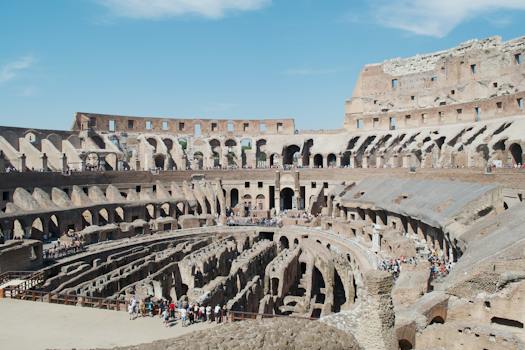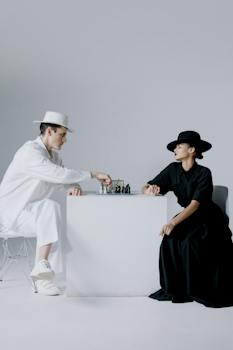

-
Table of Contents
Unleash the power of the ultimate warriors in The Ultimate Warriors of Ancient Rome: Gladiators.
Introduction
The Ultimate Warriors of Ancient Rome: Gladiators were skilled fighters who entertained audiences in the Roman Empire through combat in arenas.
The Brutal Training Regimen of Gladiators in Ancient Rome
The gladiators of ancient Rome were renowned for their incredible strength, skill, and bravery. These warriors were not born with their exceptional abilities; they were forged through a grueling and brutal training regimen. The training of gladiators was a rigorous process that pushed their bodies and minds to the limits.
The training of gladiators began at a young age, usually around the age of 12 or 13. These young boys were selected for their physical attributes and potential as future warriors. Once chosen, they were taken to specialized training schools called ludi, where they would spend the next several years of their lives.
The training regimen of gladiators was designed to transform these young boys into formidable fighters. They were subjected to intense physical exercises and combat drills. The gladiators would spend hours each day practicing with weapons such as swords, shields, and spears. They would also engage in hand-to-hand combat, learning various fighting techniques and strategies.
The physical training of gladiators was not limited to combat skills alone. They were also put through a rigorous fitness routine to build strength and endurance. This included running, jumping, and weightlifting exercises. The gladiators were expected to be in peak physical condition, as their lives depended on their ability to withstand the rigors of the arena.
In addition to physical training, gladiators also underwent mental conditioning. They were taught to be fearless and to suppress any emotions that could hinder their performance in the arena. They were trained to remain calm and focused even in the face of danger and death. This mental fortitude was crucial for gladiators, as they often faced overwhelming odds and had to rely on their training and instincts to survive.
The training of gladiators was not without its dangers. Many gladiators suffered injuries during training, some of which were severe and even fatal. However, these risks were considered a necessary part of the training process. Gladiators were expected to be willing to sacrifice their bodies and lives for the glory of the arena.
The training regimen of gladiators was overseen by experienced trainers and retired gladiators who had survived their own battles in the arena. These trainers were responsible for molding the young boys into skilled fighters. They would closely monitor their progress and provide guidance and feedback to help them improve.
The training of gladiators was a lifelong commitment. Even after they had completed their initial training, gladiators continued to practice and refine their skills throughout their careers. They would often participate in mock battles and exhibitions to showcase their abilities and entertain the crowds.
In conclusion, the training regimen of gladiators in ancient Rome was a brutal and demanding process. These warriors were pushed to their physical and mental limits in order to become the ultimate fighters. The training schools, or ludi, were the breeding grounds for these warriors, where they underwent intense physical and mental conditioning. The gladiators' training included combat drills, physical fitness routines, and mental fortitude exercises. Despite the risks and hardships, the gladiators embraced their training, knowing that it was necessary for their survival in the arena.
The Different Types of Gladiators and Their Weapons

The gladiators of ancient Rome were revered as ultimate warriors, captivating audiences with their skill, bravery, and sheer spectacle. These fighters, often slaves or prisoners of war, were trained to entertain and fight to the death in the grand arenas of Rome. While the gladiators themselves were diverse in their backgrounds and abilities, they can be categorized into different types based on their fighting styles and the weapons they wielded.
One of the most iconic types of gladiators was the murmillo. This heavily armored warrior was equipped with a large rectangular shield, known as a scutum, and a short sword called a gladius. The murmillo's helmet featured a distinctive crest, resembling a fish, which added to their imposing presence in the arena. They were often pitted against the thraex, another popular gladiator type. The thraex, inspired by the Thracian warriors, wore a distinctive helmet with a wide-brimmed visor and carried a small rectangular shield and a curved sword known as a sica. The rivalry between the murmillo and thraex was a favorite spectacle for the Roman crowds.
Another type of gladiator was the retiarius, known for their unique fighting style. The retiarius was lightly armored, wearing only a shoulder guard and a metal arm guard. Their weapon of choice was a trident, a three-pronged spear, and a weighted net. The retiarius would use their agility and speed to entangle their opponents in the net before delivering a fatal blow with the trident. They were often paired against the secutor, a heavily armored gladiator armed with a short sword and a large rectangular shield. The secutor's helmet had a rounded shape with small eye holes, allowing for better protection while still maintaining visibility.
The secutor and retiarius matchup was a classic battle of strength versus agility, with the crowd eagerly anticipating the outcome. In addition to these well-known types, there were also lesser-known gladiator types, such as the hoplomachus and the provocator. The hoplomachus, inspired by Greek hoplites, wore a full suit of armor and carried a spear and a small round shield. They were often paired against the murmillo, creating a clash of heavily armored warriors. The provocator, on the other hand, was a versatile gladiator who could adapt to different fighting styles. They wore a combination of armor from various types and were armed with a gladius and a rectangular shield.
Each type of gladiator had its own strengths and weaknesses, making the battles in the arena unpredictable and thrilling. The gladiators' weapons played a crucial role in determining their fighting style and strategy. The gladius, a short stabbing sword, was the most common weapon among gladiators. Its design allowed for quick and precise strikes, making it deadly in close combat. The trident, with its three prongs, was ideal for ensnaring opponents and delivering fatal blows. The curved sica, used by the thraex, was designed to inflict deep wounds and maximize damage.
In conclusion, the gladiators of ancient Rome were a diverse group of warriors, each with their own unique fighting style and weapons. From the heavily armored murmillo to the agile retiarius, these gladiators captivated audiences with their skill and bravery. The battles in the arena were a spectacle of strength, agility, and strategy, with the outcome often uncertain until the final blow. The gladiators and their weapons have left an indelible mark on history, forever immortalized as the ultimate warriors of ancient Rome.
The Spectacle of Gladiatorial Games in Ancient Rome
The gladiatorial games were one of the most popular and enduring spectacles in ancient Rome. These games were a form of entertainment that captivated the Roman citizens and provided a thrilling display of skill, bravery, and violence. The gladiators, who were the ultimate warriors of ancient Rome, fought in these games, often to the death, for the amusement of the spectators.
The gladiatorial games were held in large amphitheaters, such as the famous Colosseum in Rome. These arenas were specifically designed to accommodate the massive crowds that flocked to witness the spectacle. The games were organized by wealthy individuals or the state, who would fund the events and provide the gladiators with training, weapons, and armor.
The gladiators themselves were typically slaves, prisoners of war, or criminals who had been sentenced to fight as punishment. However, there were also free men who willingly chose to become gladiators, either for the fame and fortune that could be achieved or as a means of escaping a life of poverty. Regardless of their background, all gladiators were trained extensively in combat techniques and were expected to display exceptional skill and bravery in the arena.
The gladiatorial games were divided into various types of combat, each with its own set of rules and weapons. The most common type was the "munus," which involved two gladiators fighting each other to the death. These fights were often brutal and bloody, with the combatants using a variety of weapons, including swords, shields, and nets. The crowd would cheer and jeer as the gladiators clashed, eagerly anticipating the final outcome.
Another popular form of gladiatorial combat was the "venatio," which involved the hunting and killing of wild animals. These spectacles were particularly thrilling, as the gladiators would face off against ferocious beasts such as lions, bears, and even elephants. The gladiators would use their weapons and skills to outmaneuver and defeat these dangerous creatures, often at great risk to their own lives.
The gladiatorial games were not just about violence and bloodshed; they were also a means of social and political control. The games served as a way for the ruling elite to assert their power and dominance over the masses. By providing the citizens with a spectacle that was both thrilling and awe-inspiring, the ruling class could distract the population from their own grievances and maintain social order.
The gladiators themselves became celebrities in ancient Rome, with their exploits in the arena becoming the stuff of legends. Some gladiators achieved great fame and fortune, earning the adoration of the crowds and even receiving special privileges from their owners. However, for most gladiators, life was harsh and short-lived. The constant risk of injury or death, combined with the grueling training and living conditions, meant that few gladiators survived for long in the arena.
In conclusion, the gladiatorial games were a central part of ancient Roman culture and society. These spectacles provided the citizens with a thrilling display of skill, bravery, and violence, while also serving as a means of social and political control. The gladiators themselves were the ultimate warriors of ancient Rome, trained to fight to the death for the amusement of the spectators. Although the gladiatorial games were ultimately a brutal and inhumane practice, they remain a fascinating and enduring aspect of ancient Roman history.
Q&A
1. Who were the gladiators in ancient Rome?
Gladiators were trained fighters, often slaves or prisoners, who entertained audiences by engaging in combat in arenas.
2. What was the purpose of gladiator fights in ancient Rome?
The purpose of gladiator fights was to entertain the Roman audience and demonstrate the power and dominance of the Roman Empire.
3. How were gladiators trained and prepared for combat?
Gladiators underwent rigorous training in specialized schools called ludi, where they learned various fighting techniques and strategies. They were also provided with proper diet and physical conditioning to enhance their combat skills.
Conclusion
In conclusion, gladiators were the ultimate warriors of ancient Rome. They were highly trained fighters who entertained the masses with their combat skills and bravery. Gladiators came from various backgrounds and fought in different styles, showcasing their strength, agility, and endurance. Despite their dangerous and often fatal profession, gladiators gained fame, fortune, and even freedom through their victories in the arena. Their legacy continues to captivate and intrigue people today, providing a glimpse into the brutal yet fascinating world of ancient Rome.










